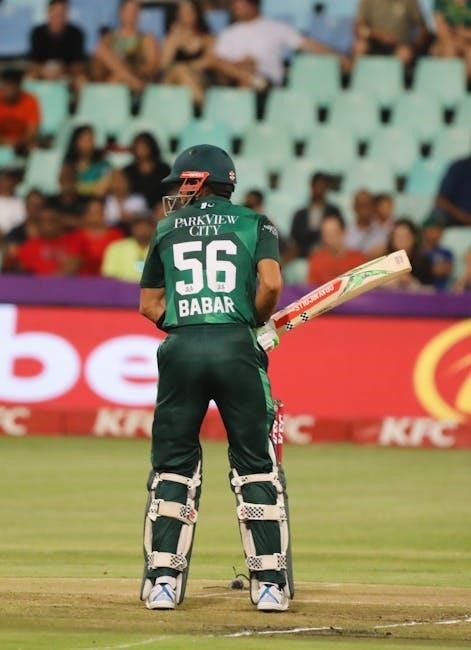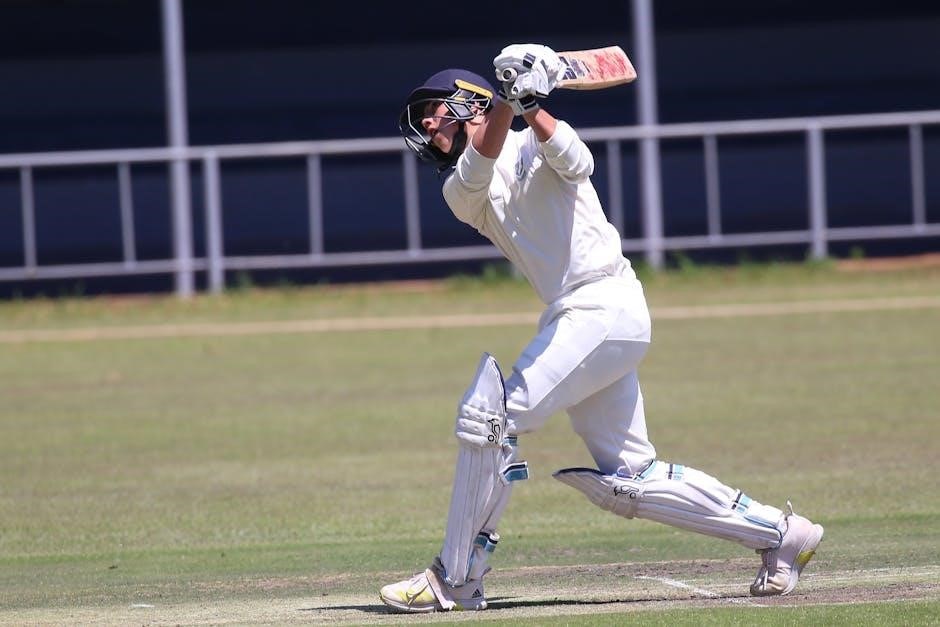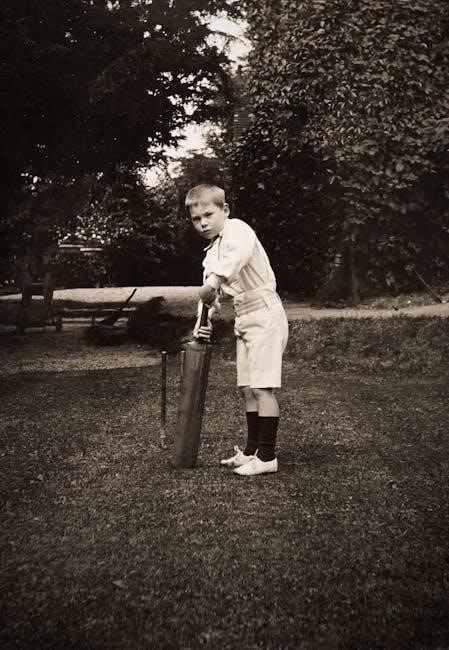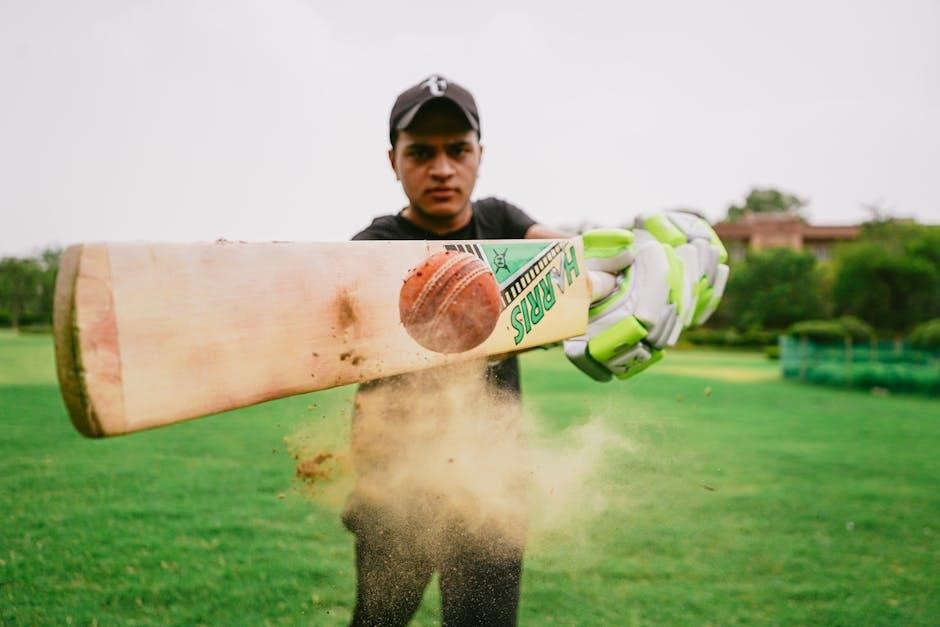
cricket bat size guide
Choosing the right cricket bat size is crucial for optimal performance, as it affects power, control, and technique. This guide helps players select the perfect bat for their height, age, and skill level, ensuring a comfortable and effective game.
1.1 Importance of Choosing the Right Bat Size
Selecting the correct cricket bat size is vital for optimal performance, as it directly impacts power, control, and technique. A properly sized bat ensures comfort, prevents discomfort or injury, and enhances skill development, especially for junior players. The right fit allows for better balance and stroke play, making the game more enjoyable and effective for players of all ages and skill levels.

1.2 Overview of Cricket Bat Sizing
Cricket bat sizing is based on player height, age, and skill level, ensuring optimal performance and comfort. Bats are categorized into sizes 0 to 6, with junior sizes for younger players and full sizes for adults. Proper sizing enhances control, balance, and technique, while also reducing the risk of injury. This guide helps players select a bat that fits their needs, promoting better gameplay and skill development.

Cricket Bat Size Chart
A cricket bat size chart categorizes bats by player height and age, providing a clear guide for selection. Sizes range from 0 to 6, with Size 0 for younger players (3-4 years) and Size 6 for taller, experienced cricketers, ensuring the right fit for optimal performance.
2.1 Bat Size by Player Height and Age
Bat size is determined by player height and age, ensuring optimal performance. Size 0 suits children aged 3-4 (below 122cm), while Size 6 is for taller, experienced players (over 188cm). Intermediate sizes (1-5) cater to growing players, with each size increasing in length and width to match physical development and strength, ensuring comfort and effectiveness in gameplay.
2.2 Bat Length and Width Measurements
Bat length and width are critical for proper sizing. Bats range from 24-33.5 inches in length and 3.5-4.25 inches in width. Size 0 (24-27 inches) suits younger players, while Size 6 (32-33.5 inches) is for taller, experienced cricketers. The width increases slightly with size, ensuring balance and swing efficiency, while the length aligns with player height and strength for optimal performance.
How to Choose the Right Bat Size
Selecting the right bat size involves measuring player height, considering age, and assessing skill level. Proper sizing ensures comfort, balance, and optimal performance, making it a vital step for all cricketers.
3.1 Measuring Player Height for Bat Size
To determine the ideal bat size, measure the player’s height accurately using a measuring tape. Stand straight with feet together, measure from the floor to the top of the head. This height is then matched to a size chart, ensuring the bat length and width are proportionate, which is essential for comfort and effective performance.
- Use a measuring tape for precise height measurement.
- Stand straight with feet together for accurate results.
- Compare the height to the size chart for the best fit.
3.2 Considering Age and Skill Level
Age and skill level significantly influence bat size selection. Junior players require lighter, smaller bats to develop technique, while seniors prefer standard or larger bats for power. Skill level also matters, as advanced players may opt for heavier bats for better performance. Always match the bat size to the player’s growth stage and ability for optimal results.
- Juniors: Lighter bats for easier handling.
- Seniors: Standard or larger bats for power.
- Skill level: Advanced players may prefer heavier bats.
3.3 Weight of the Bat and Its Impact
The weight of a cricket bat significantly impacts performance. Lighter bats (2lb 1oz ⸺ 2lb 5oz) improve control and technique, ideal for juniors or players focusing on precision. Heavier bats (2lb 6oz ⸺ 3lb 0oz) offer more power but can tire players quickly. Choosing the right weight balances power, control, and stamina, ensuring optimal performance for the player’s skill level and playing style.
- Lighter bats enhance control and technique.
- Heavier bats provide more power but reduce endurance.
- Weight selection depends on age, strength, and style.
Cricket Bat Weight Guide
Cricket bat weight varies, with junior bats weighing 1lb 13oz ౼ 2lb 5oz and senior bats ranging from 2lb 6oz ౼ 3lb 0oz, ensuring optimal performance for all players.
4.1 Junior Bat Weight Recommendations
Junior cricket bats are designed to be lighter, with weights ranging from 1lb 13oz to 2lb 5oz, depending on the size. Size 3 bats weigh 1lb 13oz ⸺ 2lb 1oz, Size 4 bats weigh 2lb 1oz ⸺ 2lb 3oz, and Size 5 and 6 bats weigh 2lb 2oz ౼ 2lb 5oz. These weights ensure young players can handle the bat comfortably, promoting proper technique and skill development without strain.
4.2 Senior Bat Weight Options
Senior cricket bats typically weigh between 2lb 6oz to 3lb, with some high-end bats reaching up to 3lb 4oz. The weight depends on the type of willow and player preference, balancing power, control, and maneuverability. Lighter bats (2lb 6oz ⸺ 2lb 10oz) suit aggressive players, while heavier bats (2lb 11oz ౼ 3lb 4oz) offer more power for experienced players.
Junior vs. Senior Cricket Bats
Junior bats are smaller, lighter, and designed for younger players, while senior bats are larger and heavier, suited for adult players. The size and weight differences ensure optimal performance for each age group.
5.1 Size Differences Between Junior and Senior Bats
Junior bats are smaller and lighter, designed for younger players, with lengths ranging from 24-27 inches and blade sizes of 4.25-5 inches. Senior bats are longer, typically 33-35 inches, with larger blades (5.5-5.75 inches), catering to adult players. These size differences ensure proper handling and performance for players of varying ages and strengths.
5.2 Material and Performance Differences

Junior bats are made from lighter materials, such as Kashmir willow, for easier handling, while senior bats use higher-grade willow for optimal performance. Senior bats offer better balance, weight distribution, and durability, making them suitable for advanced players. The material differences ensure that junior bats aid skill development, while senior bats maximize power and precision during play.

Handle Types in Cricket Bats
Cricket bats feature two main handle types: Short Handle (SH) and Long Handle (LH). SH bats are standard for most players, offering balance and control, while LH bats suit taller players, providing extra reach and leverage for powerful strokes.
6.1 Short Handle (SH) Bats
Short Handle (SH) bats are the standard choice for most players, offering a balance of power and control. They are ideal for players under 6ft 2in, providing a compact design that enhances versatility. SH bats feature a blade length of 32-33.5 inches, making them suitable for all-round performance and preferred by cricketers of various skill levels for their ease of handling and maneuverability.
6.2 Long Handle (LH) Bats
Long Handle (LH) bats are designed for taller players, typically those over 6ft, offering additional leverage for powerful strokes. The extended handle provides better control and reach, making them ideal for players with greater height. Despite the longer handle, the blade length remains standard, ensuring balance and performance for taller cricketers seeking to maximize their batting potential.

Recent Changes in Cricket Bat Regulations
Recent ICC regulations have introduced restrictions on bat dimensions, including blade length and handle size, to maintain fairness and balance between batting and bowling in the game.
7.1 ICC Regulations on Bat Dimensions
The ICC has introduced strict regulations on cricket bat dimensions to ensure fairness and consistency. Bats must now adhere to specific blade length, handle size, and overall weight limits. These rules aim to balance the game by reducing excessive bat sizes that favor batsmen over bowlers; The maximum blade length is capped, and handles must meet precise measurements. These regulations apply to all levels of cricket, ensuring uniformity and maintaining the game’s integrity.
7.2 Impact of New Rules on Players
The new ICC regulations on bat dimensions have significantly impacted players, particularly juniors, as lighter bats improve handling and skill development. Seniors face adjustments in balance and power, necessitating technique tweaks. While some resist, the rules aim to level the playing field. Players must adapt to these changes to maintain performance and compliance with the updated standards.
Tips for Maintaining Your Cricket Bat
Regularly oil your bat to maintain moisture, store it in a dry place, and avoid extreme temperatures. Proper care ensures longevity and optimal performance throughout the season;
8.1 Preparing Your Bat for Play
Preparing your bat involves oiling to maintain moisture, knocking-in to compress fibers, and applying a protective facing. Use a soft cloth for oiling and a mallet for knocking-in. This process enhances performance, prevents cracking, and ensures the bat is match-ready, optimizing its response during play.
8.2 Storage and Care Tips
Proper storage and care ensure your bat lasts longer and performs optimally. Store in a cool, dry place away from direct sunlight to prevent warping. Avoid extreme temperatures and moisture. Keep the bat in a breathable cover when not in use to protect from dust. Handle with care to avoid unnecessary damage, and avoid slamming it on hard surfaces.

Frequently Asked Questions
Players often ask about the right bat size, how to measure, and factors influencing their choice. This section addresses common queries to help you make informed decisions.
9.1 Common Queries About Bat Sizing
Players often inquire about determining the right bat size, the difference between junior and senior bats, and how age and height influence sizing. Common questions include understanding size charts, weight considerations, and ensuring proper fit for comfort and performance.
9.2 Troubleshooting Fit Issues
If a bat feels too heavy or awkward, it may be the wrong size. Check the length and weight against the size guide to ensure proper fit. Players experiencing discomfort or difficulty in handling should consider a smaller or lighter option. Consulting with experts or re-measuring height and strength can help resolve sizing conflicts effectively.
Selecting the right cricket bat size is crucial for performance and enjoyment. Use this guide to find your perfect bat and elevate your game.
10;1 Final Thoughts on Bat Size Selection
Choosing the right cricket bat size is vital for optimal performance and comfort. Consider height, age, and skill level when selecting a bat. Proper sizing enhances technique, power, and control, ensuring a better gaming experience. Always refer to size charts and guides to make an informed decision, as the right bat can elevate your game significantly.
10.2 Encouragement to Use the Guide
Using this guide ensures you find the perfect bat for your needs, enhancing performance and comfort. Whether you’re a junior or senior player, proper sizing is key to unlocking your potential. Refer to the charts and tips to make informed decisions, and enjoy a more enjoyable and successful cricketing experience. Happy batting!